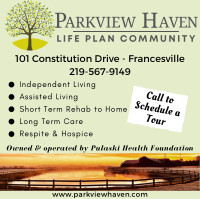CDC director highlights industry strengths, but warns of vulnerabilities
- Details
- Published: Saturday, 18 March 2017 18:50
MEDARYVILLE - Pulaski County's economy is "increasingly vulnerable" in spite of many bright indicators, warns CDC executive director Nathan Origer. He particularly cites a decreasing population as a problem factor in sustaining a workforce for local industry and a tax base for the county.
Origer made his comments in his "state of the county economy" address at the Pulaski County Community Development Commission's (CDC) annual economic summit Tuesday evening (March 14), in Medaryville.
The event was well attended by nearly 90 people, among them county commissioners Jerry Locke and Ken Becker, and county council president Jay Sullivan, and other county officials, industry and business representatives.
Following a catered dinner, Origer gave his address and then introduced keynote speaker Jeffrey Cummins, director of policy and regulatory affairs at the Indiana State Department of Agriculture.
State of the Pulaski County Economy
Every year Origer mixes good news and bad in his address, and the 2017 report was no different. But he warned that the tone of this year's address would be "a little darker" and that he hoped the message "will open eyes and serve as a call to action." To put it in the informal parlance of the day, he said, "I'm going to drop some truth bombs."
Origer's address was as follows:
The Pulaski County economy is under duress.
I don’t mean to minimize very real positives: BraunAbility’s continued investment; that Galbreath is hiring enough to justify putting up a banner; that Winamac Coil Spring is significantly outpacing the employment requirements for its forgivable loan; that Metal Fab Engineering has nearly doubled its workforce and has increased annual revenues exponentially. I could go on for days just championing the growth displayed by our existing companies.
It’s not my intention to diminish the efforts of my office, West Central Schools, Ivy Tech, the Center of Workforce Innovations, and our Pulaski County Industrial Forum to expand vocational and incumbent-employee workforce training opportunities as we have through our RAM-Tech program and Ivy Tech soft-skills classes, and as we’ll be doing through local participation in the Northwest Indiana Skill Up project.
I’m not looking to write off the great energy and momentum that we’re seeing from Wander Our Winamac and Francesville’s UpTown Project - the county's Indiana Main Street organizations - working to bring new life to our beleaguered downtowns featuring more and more empty storefronts.
No, I don’t want anyone to forget about all of these amazing things. Let us not merely be grateful, but absolutely excited that our community enjoys such blessings.
But we also have to be brutally honest with ourselves. When we look in the mirror, we should be troubled by what we see. The Pulaski County economy is increasingly vulnerable.
It is menaced by a sharply decreasing population and a directly linked diminishing labor pool. Following the 2010 Census, per which there were 13,402 Pulaski County residents, our population was projected to drop below 13,000 by 2025. We only needed until 2014 to decline that much.
Since 2010, we’ve lost almost four percent of our populace. On the plus side, the 45-64 and 65+ age cohorts are projected to increase in size, so we’ll be in the running for the new location of the Midwest Shuffleboard Championship.
Only 43 percent of BraunAbility employees live in Pulaski County today. Forty-three percent. This isn’t just c-suite executives choosing the Carmels and Lafayettes of Indiana. This is their workforce at all levels. Fewer than half of Plymouth Tube’s employees live here. The most salient basis for criticism of our proposed industrial park here near Medaryville is that we may not have the labor force to sustain growth. Without a change in population trends, our downtowns are going to decay even more.
Our local economy is further endangered by opioid abuse and other drug use. Please do not mistake my words as suggesting that drug addiction is primarily an economic threat; it’s so much worse. But it is doubtless perilous to our economy.
Whatever your personal opinions about recreational marijuana use, how reliable can a new hire possibly be when he can’t stay clean even for long enough to pass a first-day drug screen? How can we expect anyone to hire persons whose struggles with substance abuse make them a liability to profits, to equipment, and most of all, to the safety of themselves and their coworkers?
When we’re at the point at which there are only a few hundred residents who are, officially or unofficially, unemployed, and too many of them are struggling too much with inner demons to hold down a job - especially one that comes with all of the demands of factory work - things get harder for growing companies.
Of course, the current state of our local politics and governance creates hazardous conditions for the Pulaski County economy, too.
Problematically, for all intents and purposes, we are a one-party county. In 2016, two Democrats ran for county-level office. Two. Not a single Democrat vied for one of the three open at-large county council seats. This has to change.
I don’t say this because of any particular affinity for the Democratic Party, but because we’ve seen what happens when one party barely shows up on the ballot. The other becomes complacent to the point of sclerosis and has little incentive to react to criticism or to re-evaluate old ideas. I’m hopeful that the new GOP chair will spark some changes, and that Democratic leadership will find the right strategy to revive the party.
|
As I noted above, we are at the point at which our dwindling population is an acceptable reason to second-guess plans for new industrial development, but all too many of our decision-makers have seemed to be unable to follow this concern to its logical end: population decline is a problem in and of itself. Full stop.
I don’t know if it’s a head-in-the-sand unwillingness to accept this sad truth, a failure to listen to my frequent warnings, a lack of information on the part of newly elected leaders, or a perverse and morally untenable belief that this population loss is immaterial, or even a good thing, but few seem to have much interest in combating our demographic doom.
As many of you are aware, I’ve found myself locked in an ugly battle with our county commissioners over tourism marketing. I’ll be the first to admit that I have handled the public conflicts poorly and regret how I’ve expressed my frustration. How I have behaved, though, does not change the fact that we have a problem on our hands. I can’t guarantee that the proposals that I’ve presented are perfect, or that there are no flaws with our vision, but I can guarantee that we have to do something - and the CDC is trying.
Tourism promotion is a first step in the effort to rebuild our population to a sustainable level. People can’t relocate to Pulaski County if they don’t realize how great this place is. They can’t be exposed to all that our community has to offer if they don’t visit. And they can’t visit if they don’t know that we exist. Increasing tourism isn't some kind of elixir that will magically save us, and I’m not going to tell you that every transient visitor — or even every one out of ten guests — is going to relocate, but we’ll never know if we don’t try, and tourism does have a significant financial impact on our community. It’s one piece of the puzzle.
And yet, when I’ve ask for permission to spend money already in a budget approved by the CDC and the County Council, I’ve struggled to overcome skepticism and disinterest. I’ve returned with data, market research, and testimonials. I’ve presented slimmed-down proposals, including a super-cheap online-only campaign. Yet progress remains paralyzed.
Perhaps more troubling than the reluctance to acknowledge our population problem is the apparent disinterest in addressing the fact that, simply by living in Starke County, I pay roughly half as much in local income taxes as I would if I lived here. There’s no one reason why people choose to leave here, why people choose not to relocate to here, but this pummeling of the pocketbook doesn’t work in our favor — and it hurts the people who do choose to remain a part of this wonderful community.
What’s worse is that it’s often hard to see what return residents get on this “investment”. I’m struggling to use just a tiny portion of these funds to try to market Pulaski County - because, hey, if we could boost our population, then we could collect the same revenues with a lower tax rate - to say nothing of other attempts to invest in our future. Hundreds of thousands of dollars just in economic-development income-tax funds sit in the bank, accumulating almost no interest and doing nothing to improve our community. I guess the Justice Center has proven to be a good use of these funds - (and there is) only about $1.5-million left on that bill.
Okay, our income taxes are high, but we have some of the lowest property-tax rates! Sure, 15 of our 19 taxing districts have rates in the bottom 25 percent of all of Indiana, but given the structure of our tax caps, especially regarding owner-occupied homes, this statistic is pretty meaningless for the average wage-earner. The primary beneficiaries are industry and large landowners.
Once you consider that manufacturing requires a much larger workforce, which is harder to attract with our stratospheric income taxes, some of that benefit disappears. Modern farming admittedly requires a lot more land held by a lot fewer individuals, so that the total tax bill is still a burden, but on top of the workforce issue, most industrial land is within municipalities, where tax rates are higher, and industrial land is assessed much higher than farmland is valued. It becomes clear who benefit the most from this, and it’s not our manufacturers.
I’m not arguing this to earn the ire of farmers. I mean, heck, our guest speaker at our Economic Development Summit joined us from the State Department of Agriculture, and I made a point of extending a personal invitation to the Summit to our local Farm Bureau. Agriculture is a significant part of our economy, and an even more important part of our heritage. We’re never going to write it off - and, honestly, we need to do a better job of supporting it at the CDC.
But we have to be realistic about a couple of things. First, manufacturing is much more land-efficient when it comes to employment, and depending on the taxing district, it generates anywhere from seven to 12 times as much tax revenue per acre as agriculture does.Bear with me and hold on to this information for just a moment.
The other issue that we need to recognize is that people, and thus incomes, and thus income taxes, are mobile. Land is not. If we continue to rely so heavily on income taxes to fund the operations of government, we’re going to become increasingly less attractive; the fewer wage-earners we have, the more we’ll have to increase our tax rates. It’s a vicious cycle.
Last I checked, no one has figured out how to move an acre of ground to a different taxing district. No matter where the landowner lives, that land is ours to tax.
And let’s not forget who the biggest winners are here: not the large local farmers and landowners who still get to pay our high income taxes, but the out-of-county land-investment corporations who buy up thousands upon thousands of acres, pay our low property taxes, and bring in out-of-town tenants to lease the land, all while their corporate principals pay taxes on their handsome salaries at other counties’ lower rates. We’re losing out here.
I’m not suggesting that we upend our entire tax matrix and start trying to squeeze every possible penny out of the ground, but it is indisputable that we have to make some changes to how we fund our county government if we care about the future of Pulaski County. And it’s not just about cutting spending, which anyone who’s been involved in government budgeting can tell you is much easier to campaign for than to do. It’s about becoming more responsible with how we generate the revenues that we need. It’s about using those revenues to invest in our future.
Remember what I said about the employment efficiency and revenue-generation power of industrial land? Our 2010 economic-development strategic plan proposed a rail-served industrial park with an intended focus on adding value to our strong agricultural economy. This could be a tremendous investment in our future.
From day one, I’ve been working on this: contacting landowners, commissioning feasibility studies and appraisals, negotiating with landowners, and meeting with potential tenants. It’s been a long time coming, and we’re almost there. Alas, we’re at a standstill.
I have proposed a creative funding alternative that would leave tax-based funds minimally impacted after carefully considering every possible way of paying for the land. I’ve addressed every request for more information. Things have idled.
When county councilman Ken Boswell asked about workforce availability, he raised a reasonable point. I returned with data showing that even if our local labor force is a little thin, the population base within 30 to 45 minutes of Medaryville is more than sufficient to support this project, especially when you consider how many residents leave the county for work. Still nothing.
And if we don’t develop this property soon, we’re almost guaranteed to lose out on at least one of our potential tenants.
In the worst-case scenario, we see no interest in this site for a while and we generate cash rent, ultimately putting the land back on the market if the project fails. No harm done. In the best case scenario, we replace agricultural ground with industrial development that generates more property-tax income for the county, creates new jobs, and maybe spurs some new commercial growth and an increase in population. We can’t see into the future, so we’ll never know if we don’t try.
So, there you have it, the State of the Pulaski County economy. We have some great things going on, including a lot of projects that I didn’t get to mention, and about which you can read in our 2016-17 achievements report (which appears at end of this article), but there are a lot of causes for concern.
I sincerely hope that what I have said here will inspire you to take action, to speak up, to get involved. Community development is a team sport, and the bigger the team we have, the more we can do to effect change and to make Pulaski County the best Pulaski County it can be.
Show up at meetings. Call your elected officials. Run for elected office. Sign petitions. Start petitions. Write letters. Help with community projects. Join a Main Street organization. Volunteer with Junior Achievement or a youth organization. Keep yourselves informed. Do something - for yourselves, for your children, for your children’s children, and for the sandhill cranes.
Let’s make sure that Pulaski County is a place that people visit for outdoor recreation, not for the Midwest Shuffleboard Championship - although I suppose that could generate some income, too!
ISDA Keynote Speaker
Keynote speaker Jeffrey Cummins of the Indiana State Department of Agriculture told the audience that there are economic development opportunities in this region of the state.
"You are really competitive in agri-business and food processing industries in this region, Cummins reported, referring to recent national industry competitiveness studies. "In this area, your are five-and-a-half times more competitive than the rest of the U.S. You need to invest and focus your energy on this sector."
He pointed out there is a critical challenge to feed the world by 2050. "We have to meet demand and oversee trade," he said. "We're good here at producing, and we've got to get it overseas."
He added there could be future opportunities in the area in agricultural aquaculture and a resurgence in dairy production.
"We are still a manufacturing state; we just manufacture food," he said.
Cummins also noted that the Pulaski County area is two-and-a-half times more competitive in manufacturing, particularly fabricating and metal production, than the rest of the nation.
"Do a self-assessment. Decide where you want to go, then double-down on what you're good at," he recommended.
Pulaski County Community Development Commission
Achievements 2016-2017
- Facilitated local-manufacturer relationships with Center of Workforce Innovations and Ivy Tech Corporate College, partnered with Ivy Tech to provide soft-skills training for local employers, and coordinated meetings of the Pulaski County Industrial Forum.
- Coordinated meetings of the Pulaski County Human Resource Group and began countywide, cross-sector compensation survey project.
- Provided staffing for implementation of the Pulaski County Hometown Collaboration Initiative capstone project, working toward final roll-out of the Pulaski County Bike Route Network and establishment of the Pulaski County Tourism Advisory Council.
- Began implementation of the Pulaski County Repair and Maintenance Technology (RAM-Tech) vocational education program at West Central High School.
- Managed the Pulaski County Revolving Loan Fund, including the issuance of one new loan.
- Assisted BraunAbility in receiving County-level development incentives so that the company could receive State incentives for employee training.
- Partnered with Purdue Extension – Pulaski County and local schools and industries to develop Leadership Pulaski County, a program designed to educate and to cultivate local civic leaders.
- Assumed and expanded tourism-promotion responsibilities for Pulaski County, including amplified television, print, and digital marketing and increased website and social-media content.
- Director served on the Loan Approval Committee of the Regional Development Company (RDC), an SBA-504 small-business lender. This role not only exposes staff to business-growth financials, but also strengthens the connection between the RDC and potential local borrowers.
- Director visited multiple high-school and middle-school classes, participated at one middle-school function, and served on the board of directors for Junior Achievement Serving Pulaski County.
- Continued public-relations efforts through a quarterly newsletter and increased social-media presence.
- Participated in five-county Rural and Rustic Tourism Group.
- Director served as staff to the Pulaski County Advisory Commission on Industrial Affairs.
- Director served as advisor to the Advisory Plan Commission and Board of Zoning Appeals, coordinating efforts to update the Pulaski County Unified Development Ordinance (UDO), planning and residential-building fee schedules, and Rules of Procedure, and assisting the Town of Winamac in adopting the UDO as its own.
- Director served as secretary and economic-restructuring chair for the Wander Our Winamac! Main Street organization and on the organization and economic-restructuring committees for the UpTown Project, Francesville’s Main Street organization.
- Project Coordinator served as staff/market master for the Pulaski County Farmers’ Market.
- Project Coordinator served as Pulaski County coordinator for Indiana Bicentennial celebrations. Staff partnered with Chamber and Bicentennial Committee to host Pulaski County TorchFest.
- To promote regional cooperation and growth, director participated on the Northwest Indiana Forum’s Economic Development Committee, served as a secretary of the Kankakee-Iroquois Regional Planning Commission, and participated with the Region 1 Works Council.







